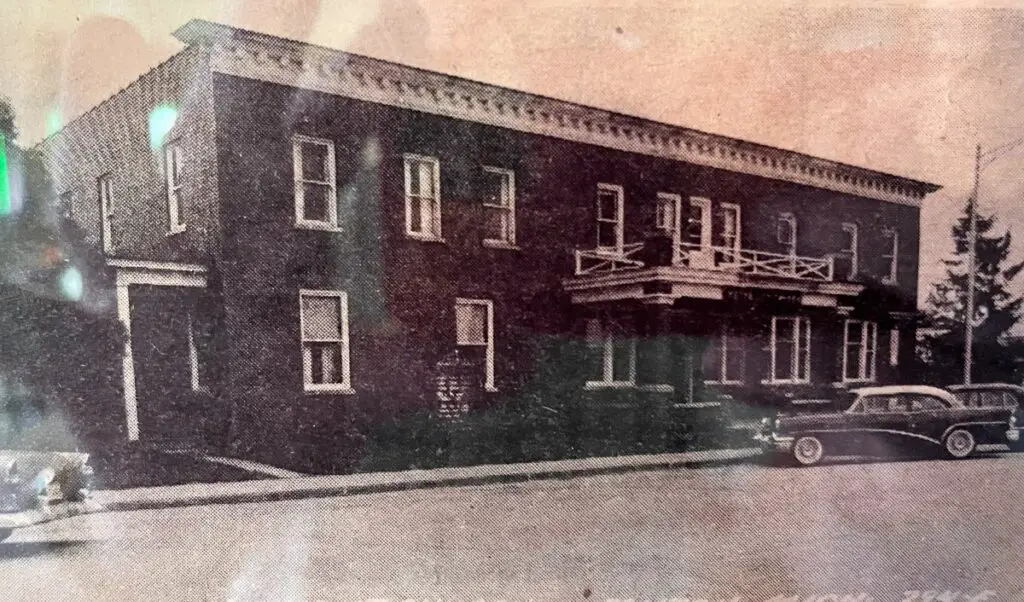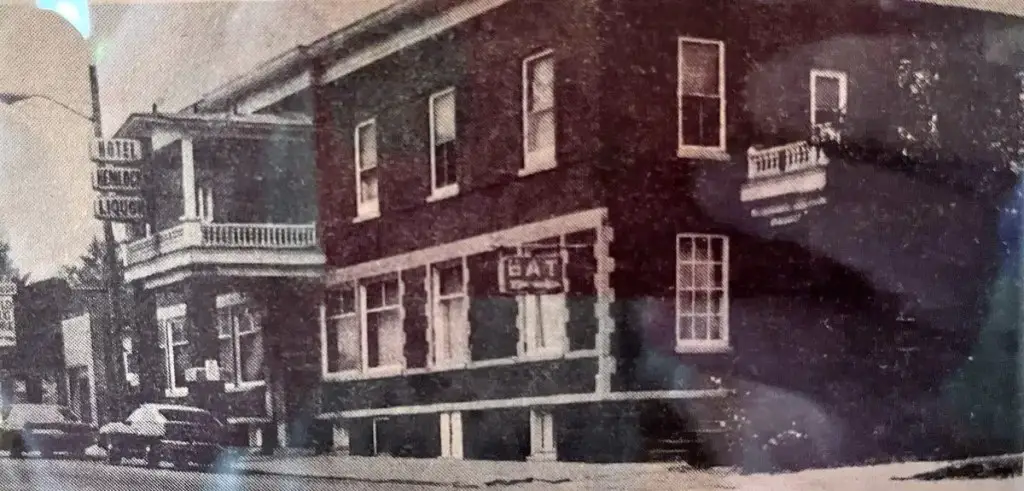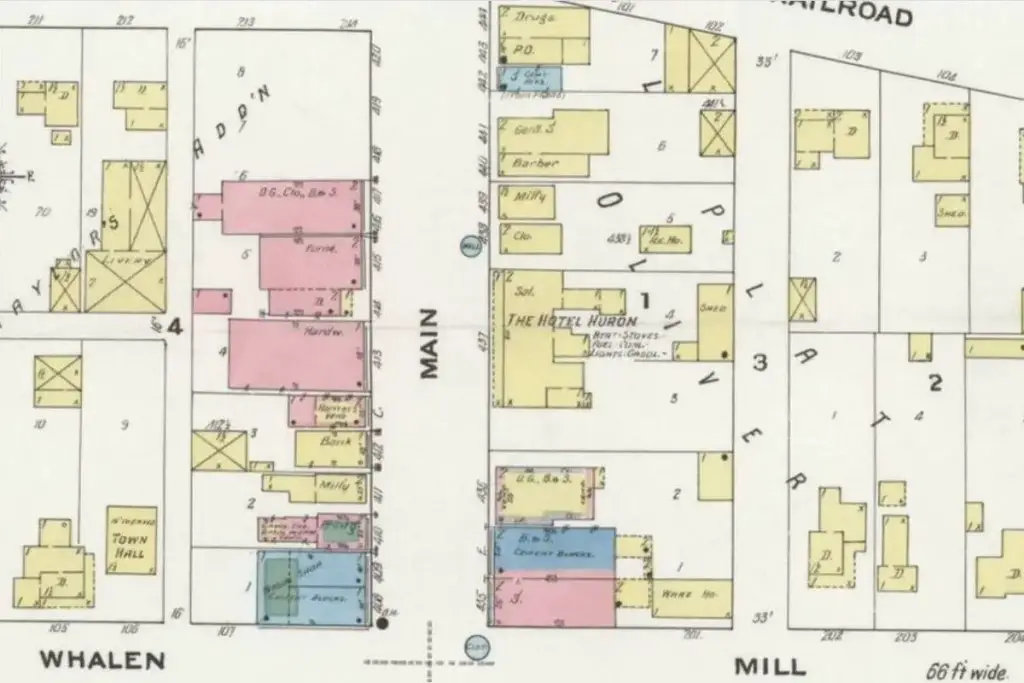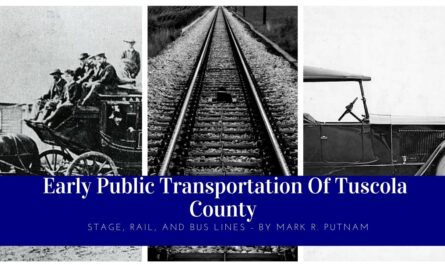From time to time, we like to visit the Hitching Post Inn Elkton Mi. It’s a great place to stop after a round of golf at Century Oaks. It’s a great place to grab a proper bar burger. It’s a fascinating old building with strange stained glass in many windows. I always wondered about the history of this building and what role it played in the community.
The Sanborn plat maps indicated the site as The Hotel Huron in 1909. It was modern for its day, with gas lighting and coal heat.
It was a hotel of some type, but what about those stained-glass windows? It wasn’t until I spied an article framed near the entryway that the history of this fascinating building came to light. It was written by Kami Buchholz. However, I’m not sure what publication it was in nor what the date was; however, I shamelessly borrowed it and presented it here, so the next time you are in Elkton, you can check it out.
Elkton’s Twin Hotel

Many years ago, after the turn of the century, Elkton was home to a hotel saloon mirrored one built in Hemlock simultaneously. Brothers Henry and Casper Gosen each were of the “twin” Elkton and hemlock businesses, respectively.
The Elkton hotel was owned and operated by Henry Gosen, was called Commercial House, and was financed by the Banner Brewing Company Saginaw. This information comes from George Neustadt, son of Charles Neustadt, who was the last proprietor of the business.
[Ed Note: The Cass City Chronicle noted on June 6th, 1902, “The Hotel Huron will be entirely remodeled by its proprietor, M. Dickenson.]
A Local Brewer Finances the Hotels

The National Brewing Company of Saginaw financed a hotel saloon in Hemlock that was an “identical twin” to the one in Elkton, except that the saloon’s location and dining area were reversed. Henry Gosen’s older brother, Casper, ran this business, according to Ozzie Bauer, a lifetime resident of the area. The two hotel saloons were designed with red paving brick at the front of the building and a veneer brick casing the back of the winged courtyard.
Both hotels had white wooden balconies—each had its unique design. As of 1955, the hotel in Hemlock is still thriving and operated by Janina Ostinowski. The 20 hotel rooms, bridal suite, two apartments, and glittering saloon are now regarded as one of the oldest buildings in Hemlock.
Since those years, the National Brewing Company is now marketing soft drinks, and the Banner Brewing Company has since burned down. And unlike the Hotel Hemlock, one of the “twins,” the Commercial House in Elkton is only a memory.
Even before the construction of the Commercial House, a white framed wood hotel with green trim stood on the site that would soon become a stately hotel and saloon. The Sophie family managed the wooden framed hotel until it burned down in 1912, according to a resident, Hue Monroe.
After a Fire, the Elkton Hotel is Rebuilt
When the Commercial House replaced the old wooden hotel, it was modern in every detail for a hotel saloon at that time. The hotel was a haven for traveling ball teams and construction workers, complete with a stable, or 10-cent barn as they were well called, numerous hitching posts (still present on the south side), and a four-car garage. The hotel was a haven for traveling salesmen, ball teams, and construction workers.
According to George Nienstadt, the workers who put the concrete pavement through Elkton in 1920 were visitors to the Commercial House. The inside was also stunning. The barroom area glistened with a 33-foot. Oak bar counter, a 13 ft. back bar counter, two 21 by 2-foot mirrors, and several tables and chairs.
Patrons of the saloon often played a variety of card games. Especially popular then were “66” euchre and an occasional game of poker in the backroom, according to Nienstadt.
The kitchen was equipped with spacious cupboards and the latest in cookware. A side entrance allowed entry to the dining area where three meals were served daily and gave hotel patrons a passage up a two-flight mahogany staircase to the upstairs rooms.
Twenty-three rooms were housed upstairs in the Commercial House. Rooms on the south wing were furnished entirely with iron or wooden beds, sheets, pillows, bedspreads, comforters, blankets, dressers, and commodes, while north wing rooms were unfurnished.
Also lining the upstairs hallways was a bathtub room with a “ladies” and “gents” bathroom on each side. Each room was equipped with a rope ladder for safety in case of fire, said Mrs. Evelyn Matteson, the former house owner.
The commercial house’s basement differed from its twin in Hemlock in that it was located below the ground. The south side was a laundry room, which caught bedding and the like from an upstairs laundry chute. The north side of the basement contained the furnace room.
Prohibition Transforms The Elkton Commerical House
When Prohibition passed, William Webber, owner of the Banner Brewing company, put the Commerical House on the market to remain afloat.
When the Elkton Methodist Church expressed interest in purchasing the building, Webber was not in favor of the sale. Still, the transition was settled because the realtor in charge of the finances was a brother to the church’s pastor, Rev. W. Ham Young.
The building underwent remodeling from top to bottom; The saloon was transformed into a sanctuary with the old bar counter serving as the altar. The upstairs portion of the north side; was removed entirely except for a portion on the left to serve as a balcony so that the sanctuary could extend upward to a full two stories.
Windows were removed, and an array of stained glass windows were placed. The dining area stairway leading upstairs was moved to face the back of the building by the spring of 1985.
The second-floor rooms were transformed into Sunday school rooms. The northside wing was extended eight feet, and a bell tower was added. Even the back bar counter, which has stored liquor bottles, now stored Sunday school supplies.
The church remained until it joined the Evangelical Church in 1970. At the time, the congregation was united and would worship in the former Evangelical Church on South Main Street.
For a brief time after the Methodist Church vacated the building, the Elkton Missionary Church used the structure while their church was being remodeled.
The 1980s Transform The Old Elkton Hotel and Church Yet Again
Terry Heck of Elkton purchased the building, and the renovation was to convert it into a dining facility.
The restaurant opened in the spring of 1985. The following winter, construction and renovation began on the former sanctuary, converting it into banquet facilities that can now hold 150 people.
In 1987, Frank and Lottie Podczervienski read the “Restaurant For Sale” ad in a newspaper. Frank’s dream was to own a restaurant. Having been in North Branch for a while and being semi-retired, the couple was somewhat restless. They decided to drive to Elkton and immediately fell in love without seeing the inside of the building.
Through the course of several years, the use of this structure has come full circle – from saloon to place of worship to family residence returning to its original concept of the restaurant.
Final Thoughts on the History of The Hitching Post Inn Elkton Mi
Stop in the inn the next time you are in Elkton, Michigan. Sadly, the 30-foot Oak bar that once graced the front of the bar is gone. However, the stained glass and much of the woodwork from the early 1900s remain.
People visiting Elkton often seek out the Hitching Post Inn Elkton Mi for its historical significance. The charm of the Hitching Post Inn Elkton Mi makes it a favorite among tourists and locals alike.





